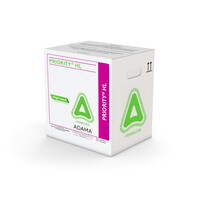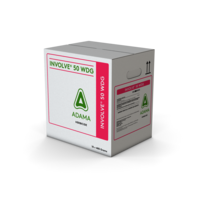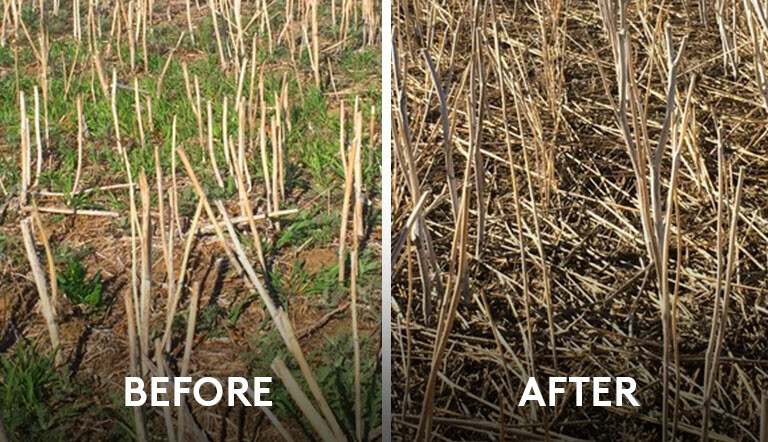
Getting the Jump on Next Year’s Weeds

POST-HARVEST HERBICIDE APPLICATION FOR HARD-TO-CONTROL PERENNIALS AND PROLIFIC WINTER ANNUALS
Spraying after harvest is complete is considered by many to be the best time for perennial weed control. Unlike annuals, perennials can live for several years, surviving our cold Canadian winters by storing food in their roots. And it’s these roots that make perennial weeds such a challenge to get rid of.
Winter annuals like Shepherd’s Purse and Narrow-leaved Hawk’s Beard can be hard to control in the spring and treating them with a herbicide application in the fall prior to snowfall can pay dividends in the spring.
One of the primary advantages of post-harvest herbicide application is that both the perennial plants and the seedlings are present and easily accessible. Also, waiting until spring to spray means the plants will be much hardier after bulking up their root systems in preparation for winter.1
Getting to the Root of the Problem
In September, the cooler night-time temperatures and shorter daytime hours are a signal to plants that winter is coming. This causes perennial weeds to move moisture and nutrients to tissues below ground so they can survive the winter and regrow in the spring.2
For example, the ubiquitous Dandelion has a thick, branched taproot up to two metres long that can delve deep underground.3 It will also produce a whole new plant even if the tiniest piece of root is left in the soil, which is why hoeing or tilling aren’t great choices for controlling Dandelions. In fact, mechanical removal can actually make things worse. When you defoliate a Dandelion, it can cause a shift of the shoot-root ratio which favours root growth, making the plant even more tenacious.4
Similarly, the seeds of Canada Thistle can go dormant for up to 20 years5 but only about 10% of Canada Thistle is spread through seed.6 Its deep roots are the real issue. The plant can regenerate from tiny fragments that are able to survive in tough conditions for over three months.5 Even a piece of root measuring about half a centimeter can grow into a new plant, ready to cause problems in the spring.5
This is an important reason why fall is a good time to clean up these hard to kill perennials. This is when these weeds are stocking up root reserves, and a fall herbicide application takes advantage of this increased nutrient flow.
Getting a Jump on Prolific Winter Annuals
Winter annual weeds germinate when the temperature begins to cool in late summer and early fall and resuming growth in early spring when they can compete with spring crops for moisture and nutrients. The recommended time to control them in the fall is from mid-October to freeze-up, preventing additional emergence after applying the herbicide.6
Narrow-leaved Hawk’s Beard is a tough-to-control winter annual and prolific seed producer, capable of generating up to 50,000 seeds. Similarly, Shepherd’s Purse typically appears in the early spring, begins flowering early and can produce seeds throughout the season
if left unchecked. Because each plant can produce up to 45,000 seeds, early control of the weed is critical.
Therefore, it’s important to focus on the prevention of seed production and the establishment of a competitive crop stand. In both cases fall herbicide applications are often the most effective, controlling plants that germinated in the late summer and fall. Preventing these plants from getting a head start on your crop in the spring will support the establishment of a competitive crop stand.
Getting Yourself Set for Spring
Controlling weeds post-harvest can help crops get off to a good start the following spring by helping to provide warmer soils for planting. Earlier weed control can reduce the mat of dead weeds that often remains after a spring burn-down, resulting in a warmer, drier seedbed that will encourage uniform emergence and seedling vigor.7
A post-harvest herbicide application can also result in less insect and disease pressure in the spring. With fewer weeds, insects and spores have fewer places to hide.8
You may find you have more time to spray post-harvest than at other times, but like most operations, this largely depends on the weather. You may have no choice than to opt out if the weather doesn’t cooperate and winter sets in early.
Climate and crop type are other considerations. Areas where winter typically arrives later may favour post-harvest spraying, while crops that are reaped earlier (such as in August) may provide a bigger window for post-harvest herbicide applications.
Another reason to consider post-harvest applications is labour. If you have hired staff who helped with harvest, you may want to ask them to stay on to assist with late-season spraying, especially since this help may not be as readily available at other times of the year.
Getting Your Timing Right
Glyphosate is particularly effective in the fall because it will get translocated down to the roots, enhancing its activity and providing
better control, but one disadvantage of post-harvest weed control has to do with timing. If you spray too early, you may face the
possibility of your herbicide application losing its efficacy.
Weeds cut by the combine need time to accumulate new leaf tissue in order to absorb herbicides applied post-harvest. A four- to six- week interval is recommended between harvest and herbicide application; if you’re combining in late August, for example, it’s a good idea to wait until mid- to late-September to spray.9
However, this brings frost into the picture. The later you get into fall, the higher the risk of a killing frost that can damage leaf tissues and bring weed development to a full stop.
Hardy perennials like Dandelion and Canada Thistle are capable of withstanding light frosts, but hard frosts (as well as droughts)will halt growth.10 As a result, herbicides like glyphosate that control weeds at the root level will lose their effectiveness.
Following a frost, it’s recommended that growers wait one to two days to check the condition of weeds before filling the sprayer. If the weeds are green and the leaf tissue is still relatively pliable, there’s hope.
Control with glyphosate may still be obtained if no more than 40% of the original leaf tissue is damaged.11 If the weeds appear to be blackened, brown or brittle, it likely means the plants are too damaged to take up herbicide, and subsequent spraying won’t be of much use.12
When applying glyphosate for post-harvest weed control, it’s recommended to spray when the plants are most actively growing– either late morning or early afternoon when temperatures are warmer and heavy dew is off the plants. Bright sunny days are also best for moving herbicides to the roots where they will have the most impact next year.13
As with all weed control, it’s important to keep a close eye on plant development. If weeds are under serious drought stress, it’s wise to wait for rain and spray a week later if weather permits.14
Getting the Right Partner
Many growers still depend on glyphosate alone as a fall burndown option, but more are beginning to understand that glyphosate alone
doesn’t get everything.
A post-harvest burndown is a good opportunity to add different tankmix partners to boost performance or increase the number of weeds controlled. Using different modes of action in your tank mix will also reduce the risk of herbicide resistance.
ADAMA Canada has some burndown solutions that can help and recommends trying these products with glyphosate for the post-harvest burndown.
In Western Canada, PRIORITY HL, when combined with glyphosate, provides the benefits of extended control of broadleaf weeds for up
to 21 days. Its active ingredient florasulam is broken down by the sun and heat. Cooler fall temperatures are ideal for longer results. Post-harvest applications can be seeded to barley, oats and wheat (spring, durum, winter) the following year.
It targets weeds including: annual grasses (with glyphosate), Cleavers, Cow Cockle, Dandelions, Narrow-leaved Hawk’s Beard (suppression only), Volunteer Canola (all types), Wild Buckwheat (with glyphosate).
This before and after photo illustrates how effective a post-harvest application of glyphosate tank-mixed with Priority HL can be in suppressing weeds.
Another option in combination with glyphosate is INVOLVE 50 WDG, with its slower systemic action that controls right down to the roots and helps prevent the regrowth of weeds. Post-harvest applications made in the fall may be seeded into a variety of cereals, pulses, canola or forages.
Its target weeds include annual grasses (when tank mixed with glyphosate), Canada Thistle (Rosette), Dandelion (up to 15 cm), Hemp Nettle (up to 15 cm), Kochia (up to 15 cm, excluding group two and nine resistant populations), Lady’s Thumb (up to 15 cm) (when tank mixed with glyphosate), Narrow-leaved Hawk’s Beard (up to eight cm), Redroot Pigweed, Volunteer Canola (all types) (up to 15 cm), Volunteer Cereals (with glyphosate).
ADAMA 2,4-D Ester 700 has the benefits of resistance management- delivering three modes of action when combined with glyphosate and INVOLVE 50 WDG to control one- to three-leaf Volunteer Canola (all types) and group two and nine resistant Kochia. There are no recropping restrictions with post-harvest applications.
Target weeds for this product include Cow Cockle (controlled by group four herbicides), Flixweed, Kochia, Lamb’s Quarters, Lady’s Thumb (use the highest listed rate for suppression), Narrow-leaved Hawk’s Beard, Prickly Lettuce, Shepherd’s Purse, Stinkweed. Volunteer Canola (all types) and Wild Mustard.
If you’re planning a post-harvest application, read herbicide labels carefully to ensure not only proper rates of application, but any possible cropping restrictions you may have for the following year.
Post-harvest White paper
About the Author
Rob Bahry (@BahryRob)
Rob is the Development and Research Manager at ADAMA Canada, where he studies evolving trends in Canadian agriculture and looks for opportunities to bring innovation to key crop protection products. He is a registered agrologist and has a Masters degree in Agronomy and Crop Science from the University of Manitoba. Prior to joining ADAMA, Rob worked with a crop nutrition company studying the impact of environmental stress on key field crops. Rob lives in Winnipeg, Manitoba, with his family, his dogs and his favourite team – the Winnipeg Jets.
Footnotes
1 Agriculture: Controlling Dandelion in the Fall.” Manitoba.gov. Online. Accessed 14 September 2017. https://www.gov.mb.ca/agriculture/crops/weeds/print,controlling-dandeli…
2 “FAQ on pre- and post-harvest Roundup applications for perennial control.” Cargill Expert’s Blog. Online. https://www.cargillag.ca/expert-network/expert-blog/faq-roundup-perenni…
3 Stewart-Wade, S.M., Neumann, S., Collins, L.L., and Boland, G.J. “The biology of Canadian weeds. 117. Taraxacum officinale G. H. Weber ex Wiggers.” Canadian Journal of Plant Science. Oct 2002. Online. http://www.uoguelph.ca/~plpathol/PDFs/Stewart-Wade%20et%20al%20(2002).p…
4 Stewart-Wade, S.M., Neumann, S., Collins, L.L., and Boland, G.J. “The biology of Canadian weeds. 117. Taraxacum officinale G. H. Weber ex Wiggers.” Canadian Journal of Plant Science. Oct 2002. Online. http://www.uoguelph.ca/~plpathol/PDFs/Stewart-Wade%20et%20al%20(2002).p…
5 Kimmel, Nicole. “Canada Thistle.” Alberta Agriculture and Forestry. 9 Jan 2015. Online. http://www1.agric.gov.ab.ca/$department/deptdocs.nsf/all/prm2585
6 “Winter annual and perennial weed control”, Alberta Agriculture and Irrigation. Online. https://www.alberta.ca/winter-annual-and-perennial-weed-control
7 “Post Harvest Treatment for Corn and Soybeans.” Dupont Crop Protection. Online. http://www.dupont.com/products-and-services/crop-protection/corn-protec…
8 “Post Harvest Treatment for Corn and Soybeans.” Dupont Crop Protection. Online. http://www.dupont.com/products-and-services/crop-protection/corn-protec…
9 “FAQ on pre- and post-harvest Roundup applications for perennial control.” Cargill Expert’s Blog. Online. https://www.cargillag.ca/expert-network/expert-blog/faq-roundup-perenni…
10 “Winter Annual and Weed Control: FAQs.” Alberta Agriculture & Forestry. Online. Accessed 14 September 2017. http://www1.agric.gov.ab.ca/$department/deptdocs.nsf/all/faq7331
11 “Fall Weed Control and Frost”. Canola Watch. 2 Oct 2013. Online. http://www.canolawatch.org/2013/10/02/fall-weed-control-and-frost/
12 “Weed Management.” Canola Council of Canada Canola Encyclopedia. Online. http://www.canolacouncil.org/canola-encyclopedia/weeds/weed-management/
13 “Weed Management.” Canola Council of Canada Canola Encyclopedia. Online. http://www.canolacouncil.org/canola-encyclopedia/weeds/weed-management/
14 “Controlling Weeds Post-Harvest in Winter Wheat.” University of Nebraska-Lincoln Institute of Agriculture and Natural Resources Cropwatch. Online. http://cropwatch.unl.edu/controlling-weeds-post-harvest-winter-wheat
Related Articles
Related Products

PRIORITY® HL
NEW the ideal glyphosate tank-mix partner for pre-seed/post harvest burn-off upgraded with a convenient high load formulation!

INVOLVE® 50 WDG
ADAMA’s Group 2 herbicide for control of broadleaf and grassy weed pre-seed, in-crop, post-harvest and summerfallow applications.

2,4-D Ester 700
A Group 4 liquid herbicide providing effective control of difficult weeds in cereals, field corn, pastures and non-crop land.
